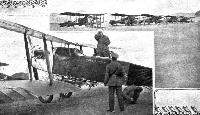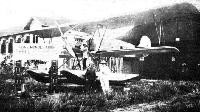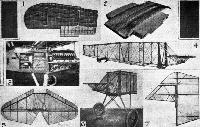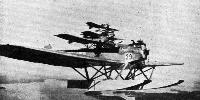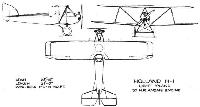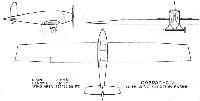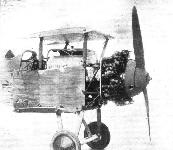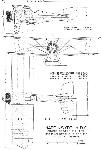Фотографии
-
Регистрационный номер: H-NACC THE DUTCH FLIGHT TO JAVA: The Fokker F.VII Commercial Monoplane, fitted with a Rolls Royce "Eagle IX" engine on which Mynheer van der Hoop (insert left), and Lieut, van Weerden Poelman, with engineer van den Broeke, have just completed a flight from Amsterdam to Batavia (Java) in the Dutch East Indies,
Самолёты на фотографии: Fokker F.VII / C-2 / F.XIV - Нидерланды - 1924
-
AIR MAIL SERVICES IN COLOMBIA: In our issue for October 23 we published a report on the successful air mail services operated in Colombia by the "Scadta." We reproduce photograph showing one of the Junkers seaplanes, which are employed on portions of the service, starting from the Magdalena river for Bogota.
Самолёты на фотографии: Junkers F 13 - Германия - 1919
-
BRISTOL FIGHTERS IN MOROCCO: Above, a batch of Bristol Fighters lined up ready for active service with the Spanish Aviacion Militar against the Moors. Below, General Lanjurjo of the Spanish Aviacion Militar alighting from a Bristol Fighter after a flight over the enemy line.
Самолёты на фотографии: Bristol F.2A/F.2B Fighter - Великобритания - 1916
-
THE FLIGHT TO INDIA: On November 20 Air Vice-Marshal Sir Sefton Brancker, Director of Civil Aviation, started on his flight to India on a D.H.50 biplane (Siddeley "Puma") piloted by Alan Cobham. The accompanying photograph shows the "50" being filled with "B.P." fuel prior to the departure from Stag Lane Aerodrome. Incidentally, "B.P." originates from the Persian Oil Fields, one of the countries to be traversed in the course' of the flight, so here, perhaps, is a modern version of "taking coals to Newcastle."
Самолёты на фотографии: De Havilland D.H.50 - Великобритания - 1923
-
Регистрационный номер: G-EBJG THE PARNALL "PIXIE III" LIGHT 'PLANE: This photograph shows the machine in monoplane form, but it will be recollected that it can be converted into a biplane, and that, as a matter of fact, it flew in this guise at Lympne. The machine shown is that carrying the number 18 in the competitions. Mr. Frank Courtney is in the pilot's seat, and Mr. Harold Bolas is the passenger on this occasion.
Самолёты на фотографии: Parnall Pixie - Великобритания - 1923
-
MAJOR ZANNI'S WORLD FLIGHT: The above photograph shows Major Zanni's Fokker-Napier arriving at Hinandi, Iraq. The Argentine airman has got as far as Tokio, but owing to the lateness of the season he has decided to abandon the flight. Major Zanni has taken 19 flying days for his Amsterdam-Tokio flight - one day less than Pelletier d'Oisy's Paris-Tokio flight. The first 7,500 miles (Amsterdam-Hanoi) was accomplished in 17 flying days and with one Napier "Lion." Then the machine stuck in the mud and was crashed. The rest of the journey was completed on a new Fokker-Napier. Major Zanni, in a cable from Tokio, says :- "Very delighted state two Napier engines worked admirably until now without slightest indication trouble wear, and without any necessity change or touch parts."
Самолёты на фотографии: Fokker C.IV / DC.I - Нидерланды - 1923
-
Maj. Zani's World Flight: Maj. Zani, the Argentine airman, who has been attempting a round-the-world flight on a Fokker biplane fitted with a Napier "Lion" engine, has, after reaching Tokio, postponed the flight owing to the lateness of the season. The annexed photograph shows the seaplane model, at Haiphong, being refuelled with "Shell," which Maj. Zani said he "considered to be the best which I have ever used throughout the whole of my career as an aviator. By its unvarying quality it permits one to obtain from the engine the maximum power without imposing any strain."
Самолёты на фотографии: Fokker C.IV / DC.I - Нидерланды - 1923
-
PEACETIME PRODUCTION: A view inside the Fokker works at Amsterdam, showing a batch of Fokker D.XIII single-seater chasers. These machines, a specimen of which will be exhibited at the Paris Aero Show, are fitted with Napier "Lion" engines.
Самолёты на фотографии: Fokker D.XIII - Нидерланды - 1924
-
THE CURTISS P.W.8 PERSUIT BIPLANE: A successful American single-seater fighter, fitted with a Curtiss D.12 engine. It was on this type of machine that Lieut. R. L. Maughan made his great Dawn-to-Dusk flight from New York to San Francisco, on June 23 last.
Самолёты на фотографии: Curtiss PW-8 - США - 1923
-
SOME CONSTRUCTIONAL DETAILS OF THE CURTISS P.W.8: 1. One of the "cellular" wing panels, which is covered with Curtiss-ply. 2. Centre-section wing radiator unit. 3. Engine and fuel tank section of the fuselage. 4. The tubular steel fuselage. 5 and 7. The welded steel tail units. 6. Engine mounting.
Самолёты на фотографии: Curtiss PW-8 - США - 1923
-
FORMATION FLYING IN SWEDEN: Our photograph shows one side of a formation of S.11 Svenska Aero A.B. seaplanes during practice. The photograph, which was taken from the Squadron-Leader's machine, shows typical Swedish "country" below.
Самолёты на фотографии: Heinkel HE.1 - HE.5, HE.8 - HE.9 - Германия - 1923
-
CLOSE-HAULED: These two photographs show the Rohrbach Ro.II, two Rolls-Royce "Eagle" engines, rigged with jury masts and sails. The machine is thus to some extent independent of wind direction, and can proceed slowly in case of total engine failure. The Rohrbach Metal Aeroplan Company A/S, of Copenhagen, in sending us these photographs, state that the Ro.II, on October 24, established the following world's records: Speed over 500 km. from 122.9 km./h. (76.8 m.p.h.) to 157 km./h. (98 m.p.h.); speed over 1,000 km. from 119.54 km./h. (74.75 m.p.h.) to 153.5 km./h. (96 m.p.h.). Distance with useful load of 250 kg. from 925 km. (578 miles) to 1,102 km. (690 miles); distance with useful load of 500 kg. from 750 km. (470 miles) to 1,102 km. (690 miles).
Самолёты на фотографии: Rohrbach Ro.II - Ro.IV - Германия - 1923
-
Регистрационный номер: G-EAPF THE AUSTIN "WHIPPET": Fitted with a six-cylinder Anzani engine of 45 h.p. this machine has an excellent performance coupled with low landing speed. It is used by an Air Force Officer as a run-about, and has been in service for some four or five years.
Самолёты на фотографии: Austin Whippet - Великобритания - 1919
-
WINNER OF THE PRESIDENT'S TROPHY: The Aero 18b is fitted with a 300 h.p. Walter engine. In the race it attained an average speed of 164-5 m.p.h.
Самолёты на фотографии: Aero A.18 / A.20 - Чехословакия - 1923
-
A NEW GERMAN LIGHT PLANE: The "BAG E.l" Bahnbedarf Darmstadt on which recently Herr Botsch flew from Darmstadt to Johannisthal (Berlin), a distance of 310 miles, in 3 1/2 hours.
Самолёты на фотографии: Darmstadt / Bahnbedarf AG BAG E.I - Германия - 1924
-
This photograph gives a good idea of the engine cowling, wing attachment, pilot's cockpit, etc., of the Darmstadt "BAG E.l." The engine is a Blackburne.
Самолёты на фотографии: Darmstadt / Bahnbedarf AG BAG E.I - Германия - 1924
-
THE DORMOY "BATH TUB" AT DAYTON: This parasol monoplane, with short nacelle and open tail booms, is fitted with a four-cylinder Henderson engine.
Самолёты на фотографии: Dormoy Bathtub - США - 1924
-
THE MUMMERT LOW-WING MONOPLANE: This machine won one of the events at Dayton. Note the very wide wheel-track. The engine is a Harley-Davidson.
Самолёты на фотографии: Mummert V-2 Sport Plane - США - 1923
-
AN AMERICAN LIGHT 'PLANE: Front view of the Driggs-Johnson monoplane, with four-cylinder Henderson air-cooled engine.
Самолёты на фотографии: Driggs-Johnson DJ-1 Bumblebee - США - 1924
-
THREE-QUARTER FRONT VIEW OF THE DRIGGS-JOHNSON LIGHT MONOPLANE: Note the celluloid window surrounding the cockpit. The engine is supplied with air for cooling through the scoop under the airscrew, and through louvres in the sides of the cowling. Entrance to the cockpit is by the door on the port side.
Самолёты на фотографии: Driggs-Johnson DJ-1 Bumblebee - США - 1924
-
THE DRIGGS-JOHNSON LIGHT MONOPLANE: Side view. The wing is covered with ply-wood up to the rear spar.
Самолёты на фотографии: Driggs-Johnson DJ-1 Bumblebee - США - 1924
-
Регистрационный номер: H-NACE The "Holland H.2" Light 'Plane: This is a single-seater monoplane, a development of the Carley light monoplane built last year. It has a 25 h.p. Anzani engine.
Самолёты на фотографии: Holland (VIH) H.2 - Нидерланды - 1924
-
The "Holland H.1" biplane: This is a two-seater machine which may be described as a light 'plane "just growing up." It is fitted with a 30-35 h.p. Anzani engine.
Самолёты на фотографии: Holland (VIH) H.1 - Нидерланды - 1924
-
The "Holland H.1" biplane: Three-quarter rear view.
Самолёты на фотографии: Holland (VIH) H.1 - Нидерланды - 1924
-
Holland H-1 Light 'Plane 35 hp Anzani Engine
Самолёты на фотографии: Holland (VIH) H.1 - Нидерланды - 1924
-
THE CASPAR LIGHT MONOPLANE: Three-quarter front view. The engine is an A.B.C. "Scorpion."
Самолёты на фотографии: Caspar C.17 - Германия - 1924
-
The Caspar light monoplane has its wings flexibly mounted by means of springs so as to take advantage of pulsating winds. The number of ribs has been reduced to a minimum.
Самолёты на фотографии: Caspar C.17 - Германия - 1924
-
Caspar C.17 20 hp. A.B.C. Scorpion Engine
Самолёты на фотографии: Caspar C.17 - Германия - 1924
-
THE MARTINSYDE A.D.C.1: Front view. The engine is an Armstrong-Siddeley "Jaguar."
Самолёты на фотографии: Martinsyde A.D.C.1 / Nimbus - Великобритания - 1924
-
The Martinsyde A.D.C.1: View of engine mounting, etc. This photograph was taken before covering.
Самолёты на фотографии: Martinsyde A.D.C.1 / Nimbus - Великобритания - 1924
-
The Martinsyde A.D.C.1: View from above showing cockpit, guns, etc.
Самолёты на фотографии: Martinsyde A.D.C.1 / Nimbus - Великобритания - 1924
-
Perspective sketch of the tubular engine mounting of the MartinSyde A.D.C.1: The "Jaguar" engine can be removed from the machine by undoing the four corner bolts.
Самолёты на фотографии: Martinsyde A.D.C.1 / Nimbus - Великобритания - 1924
-
The machine-guns on the Martinsyde A.D.C.1 are very accessible. This sketch shows how the two sliding doors on the deck fairing allow of getting at the gun mechanism. The port chute for the empty cartridges can also be seen.
Самолёты на фотографии: Martinsyde A.D.C.1 / Nimbus - Великобритания - 1924
-
The simple gravity petrol system of the Martinsyde A.D.C.1. The upper pipe is for priming, and conducts petrol to the induction system of the engine.
Самолёты на фотографии: Martinsyde A.D.C.1 / Nimbus - Великобритания - 1924
-
Martinsyde A.D.C.1 Single Seater Fighter 380 hp. Armstrong Siddeley "Jaguar" Engine
Самолёты на фотографии: Martinsyde A.D.C.1 / Nimbus - Великобритания - 1924
Статьи
- Flight


